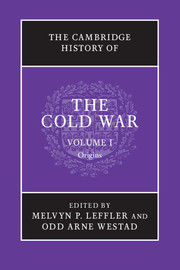Book contents
- Frontmatter
- 1 The Cold War and the international history of the twentieth century
- 2 Ideology and the origins of the Cold War, 1917–1962
- 3 The world economy and the Cold War in the middle of the twentieth century
- 4 The emergence of an American grand strategy, 1945–1952
- 5 The Soviet Union and the world, 1944–1953
- 6 Britain and the Cold War, 1945–1955
- 7 The division of Germany, 1945–1949
- 8 The Marshall Plan and the creation of the West
- 9 The Sovietization of Eastern Europe, 1944–1953
- 10 The Cold War in the Balkans, 1945–1956
- 11 The birth of the People’s Republic of China and the road to the Korean War
- 12 Japan, the United States, and the Cold War, 1945–1960
- 13 The Korean War
- 14 US national security policy from Eisenhower to Kennedy
- 15 Soviet foreign policy, 1953–1962
- 16 East Central Europe, 1953–1956
- 17 The Sino-Soviet alliance and the Cold War in Asia, 1954–1962
- 18 Nuclear weapons and the escalation of the Cold War, 1945–1962
- 19 Culture and the Cold War in Europe
- 20 Cold War mobilization and domestic politics: the United States
- 21 Cold War mobilisation and domestic politics: the Soviet Union
- 22 Decolonization, the global South, and the Cold War, 1919–1962
- 23 Oil, resources, and the Cold War, 1945–1962
- Bibliographical essay
- Index
- References
5 - The Soviet Union and the world, 1944–1953
Published online by Cambridge University Press: 28 September 2010
- Frontmatter
- 1 The Cold War and the international history of the twentieth century
- 2 Ideology and the origins of the Cold War, 1917–1962
- 3 The world economy and the Cold War in the middle of the twentieth century
- 4 The emergence of an American grand strategy, 1945–1952
- 5 The Soviet Union and the world, 1944–1953
- 6 Britain and the Cold War, 1945–1955
- 7 The division of Germany, 1945–1949
- 8 The Marshall Plan and the creation of the West
- 9 The Sovietization of Eastern Europe, 1944–1953
- 10 The Cold War in the Balkans, 1945–1956
- 11 The birth of the People’s Republic of China and the road to the Korean War
- 12 Japan, the United States, and the Cold War, 1945–1960
- 13 The Korean War
- 14 US national security policy from Eisenhower to Kennedy
- 15 Soviet foreign policy, 1953–1962
- 16 East Central Europe, 1953–1956
- 17 The Sino-Soviet alliance and the Cold War in Asia, 1954–1962
- 18 Nuclear weapons and the escalation of the Cold War, 1945–1962
- 19 Culture and the Cold War in Europe
- 20 Cold War mobilization and domestic politics: the United States
- 21 Cold War mobilisation and domestic politics: the Soviet Union
- 22 Decolonization, the global South, and the Cold War, 1919–1962
- 23 Oil, resources, and the Cold War, 1945–1962
- Bibliographical essay
- Index
- References
Summary
By mid-1944, the end of the war was finally within sight. After the great battle of Kursk and the D-Day invasion of Normandy, the Axis powers were in retreat. Soviet leaders began to look ahead, sorting out their agenda and priorities for the postwar period.
The war losses of the USSR were staggering: the country lost at least 27 million people and about a quarter of its reproducible wealth; over 1,700 cities and towns were destroyed and more than 31,000 industrial enterprises demolished. With its human resources depleted and much of its productive capacity destroyed, the country faced a huge task of postwar reconstruction. Yet there was also a new sense of optimism and self-confidence among the populace justly proud of defeating the Nazi juggernaut which the rest of the world could not stop. The Stalinist system survived the test, having proved its ability to concentrate resources, maintain internal discipline, and act decisively under enormous pressure. The Great Patriotic War (as World War II came to be called in the USSR) endowed the Communist regime with broader legitimacy and brought Iosif Stalin to the peak of his popularity.
Externally, the Soviet position was also marked by contradictions. On the one hand, the coming victory was bound to bring the USSR to new heights of strategic and political influence. Its two mortal enemies – Germany and Japan — laid prostrate; its military predominance over the Eurasian landmass seemed assured along with a new status as a great power and a key member of the victorious Grand Alliance.
- Type
- Chapter
- Information
- The Cambridge History of the Cold War , pp. 90 - 111Publisher: Cambridge University PressPrint publication year: 2010
References
- 8
- Cited by

